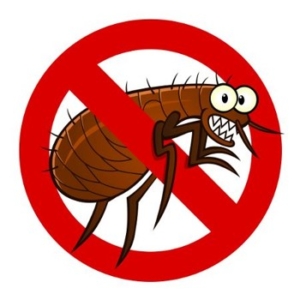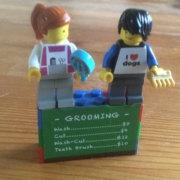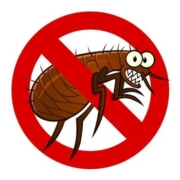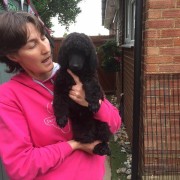Doggy Teeth Cleaning
/in Brushing Your Dog, Grooming, OAP Dogs, Puppies, Teeth cleaning, Top Tips, Uncategorized /by Caroline StillCleaning your dog’s teeth
As with us humans, keeping your dog’s teeth clean is very important to avoid plaque build-up and dental disease. Dental disease is very common in dogs, second only to ear infections, and can be extremely uncomfortable – much like we would experience.
And some breeds are more susceptible to dental disease than others, for example, Brachycephalic dogs, like Pugs and Chihuahuas, have poorly aligned jaws with crowded or absent teeth
As with everything its always easier to start teeth cleaning when they’re a puppy and brush their teeth every day to get them used to it. However, if you haven’t been able to do this then gradually introduce the activity by having your finger near their mouth. Maintain the habit and slowly introduce brushing until this is natural.
You’ll need a to buy a dog toothpaste as human ones aren’t suitable. A special dog toothbrush that goes over your finger can be used to brush their teeth, otherwise you could use a child sized toothbrush.
You should keep brushing their teeth as part of a regular grooming routine.
When to contact your vet
Regular brushing can keep plaque and dental disease away, but you must contact your vet if your dog has any urgent symptoms such as:
- Bleeding or damaged gums
- Mouth is infected giving off a fouler than usual smell
- Discoloured teeth that die and fall out
- Sensitive or painful teeth
- Noticeable difficulty in eating.
Emmi-Pet Ultrasonic Toothbrushing
- Stylish Fido uses an Emmi-Pet ultrasonic toothbrush to clean your dogs’ teeth. It is completely silent, non-vibrating and non-invasive as it is held against the teeth with no brushing action resulting in a much calmer experience for your dog. Find out more on the ultrasonic toothbrush blog.
Fireworks, loud noises, puppies and desensitisation
/in Fireworks, Puppies, Stress, Top Tips /by Caroline StillFireworks, loud noises and things that go bump in the night!
I want to talk about Firework and loud noise desensitisation …yes, we need to start early, especially for our puppies who were born after last November, but also for our oldies that are noise sensitive. My Willow hates loud bangs and noises, fireworks week and New Year’s Eve is a stressful time for this house, so I invite you to join me on our journey to help him and your dog together.
I will break this down into two parts –
1- Puppies – Introduction of these noises to puppies who are currently happy energetic care-free souls.
2 – Helping dogs that already have a fear of fireworks/noises
Puppies
We need to be good teachers and caregivers for our new puppies, so along with feeding them, walking them appropriately and playing with them, they need to be introduced to all manner of noises and experiences that they may encounter over their lives. If we can do this in a safe environment at a pace that they can cope with and with positive consequences, (eg without overloading them or causing distress) then we can help our puppies grow into very adaptable and well rounded adult dogs.
Try and think of puppies as sponges for knowledge and forever practicing for their adult life, but who need careful handling and positive experiences.
Just as we need to introduce puppies to children, adults, other dogs, the hoover at home, children running past them in the street, travelling in the car, going to the vets, having their first groom, we need to devote some time to introduction to things they may not experience for a few months. If we do not introduce these things early or in a controlled manner, by the time fireworks night comes around, we have sometimes lost that vital opportunity. Preparation is definitely our friend.
One of the best resources I have found for the introduction to fireworks (and indeed many strange noises that dogs may encounter but not always in your own home), is on the Dogs Trust website. Their Sound Therapy for Pets page includes downloadable guides and ‘scary sounds’ tracks with full instructions on how to introduce noises.
https://www.dogstrust.org.uk/help-advice/dog-behaviour-health/sound-therapy-for-pets
I can’t stress strongly enough that you start this process today. It only takes a little time each week, but will be a massive investment for your dog. He will thank you for it, and you will be so glad you did, as trying to comfort or distract a dog that is digging a hole in your carpet to hide from a week of fireworks can be very distressing for everyone.
Adult or already noise sensitive dogs
If you have a rescue dog (like my Willow), or older dog that has been scared at some time and is now fearful of fireworks, the Sounds Therapy for Pets at the Dogs Trust can also help your adult dog on a path to recovery.
How I am using sound therapy with Willow
As I am typing this blog, I am playing one of the tracks on my computer at a low level whilst Willow is sleeping and although I know he can hear them, because it is at a low level, it is below his threshold for jumping up and barking furiously. This is exactly what I need to do for him. Over time, I will play the noises a little louder every week, so that hopefully, by fireworks night I should be able to play quite loud fireworks sounds on speakers which he will be accustomed to, and more importantly will not react to. Which means we will all have a calmer evening.
Please do seek professional help if you are finding any problems with desensitising your dog to fireworks noises, it can be a very stressful and traumatic time for animals, but there is help out there. As a TTouch practitioner, I have worked with many noise sensitive dogs and had great results, but each dog is different and may need different training techniques.
Pests!
/in Coat Care, Fleas, Grooming, Puppies, Top Tips /by Caroline Still
Pest prevention – how I protect my cats and dog
I won’t bore you with all the different types of fleas, worms and ticks, there is plenty of information and scary pictures on the internet! I thought I might share with you what remedies I have used on my own animals to prevent problems and protect them from these dreaded pests.
Do speak to your Vet if you want recommendations as their products are, of course, very effective. I am not able to advise on treatments for your pets as I am not a vet, but I thought you might find it interesting if I shared with you what I do with my own pets.
Fleas
Fleas can be found anywhere, in grass, on other pets, commonly on cats and bedding, so dogs often come into contact with them on a daily basis being out and about. It’s practically impossible for your dog to not pick them up, and some dogs seem to be more attractive to fleas than others. I had a dog years ago that never seem affected, but cats that always needed preventative action!
In the past, when I have had a problem with fleas, it’s usually the cats that bring them in. I have 2 cats, and so as soon as they start scratching, I have no choice but to give them a spot-on treatment (which they hate of course), but one is allergic to flea bites and ends up in a terrible mess if she is bitten and scratches.
Bill also had spot-on treatments, but we also tried the pill kind which was easier to administer and doesn’t leave product on the coat to be touched by humans. They both seemed to work.
There are collars that can be used – these types of collars can be left on for 6 months and can get wet if your dog likes a swim or goes out in the rain, although I always take them off when washing. Do your research on these too. They are chemical heavy, but I have used one in the past.
At the moment I use CSJ Billy No Mates herbal additive that I put into Willow’s food. This needs a few weeks to start taking effect, so I started this last month in good time for the season. This is available from all good pet stores, or online.
Another great anti-flea remedy I use is raw garlic, but this must be crushed and left for at least 10 mins before it can be put in the food. Again, please do your own research on this, but it seems to have other great benefits too.
Worms
For worms, I don’t regularly treat my pets with chemicals, but I do add some Diatomaceous Earth (DE) to their food to kill any worms and I routinely check if Willow has any using a fantastic service called wormcount.com that checks all bugs in his poop. Yes, you have to send poop in the post to them, but it’s very easy! I have never seen a positive result for worms, but if I did, the DE would be adjusted to kill them, then I would retest. Please be very careful with Diatomaceous Earth, as breathing it in is dangerous, but eating it is fine. I buy human grade from imbaliridgebacks.co.uk it can also be used as a dust for killing fleas, but again you have to be very careful.
Ticks
For ticks, I use an herbal anti-tick spray that I spray on his legs if we are off walking in long grass that ticks don’t much like, and I have had very few instances of ticks.
I think using as much herbal and natural products as possible is definitely the way I like to go, I must admit, if there is a problem I will reach for more chemical products, but only as a last resort for me. I prefer the greener and more naturalistic route where I can.
Handling – How to help your dog
/in Brushing Your Dog, Good Handling, Grooming, Puppies, Top Tips, Training /by Caroline StillGetting your dog used to being handled
Helping to understand what a dog experiences when at the groomer will help you prepare your dog.
Picking up
I need to be able to be pick your dog up to be put into the bath and carried across to the table. Is your dog happy being picked up? Look for stress signs and work on happy handling.
Jumping – It would also help if your dog is able to jump into the bath (baths can be lowered to around the height of a sofa or car footwell). Or, if they cannot jump, be able to pop their front legs into the bath and I can then lift their back legs in for them.
Washing and drying
Being comfortable being washed with a shower, including being able to stand whilst being lathered with shampoo and being rinsed off, lifting up each paw and cleaning in-between the pads.
When on the table for drying and trimming, one of the trickiest parts is usually drying and brushing through.
Stand!
We are very good at teaching our pups and dogs to sit. This is a lovely exercise for you and your dog and it teaches control and good manners, but do take the time to also teach a Stand command. It is one of the most time-consuming efforts for a groomer to keep gently encouraging a dog to keep standing, and must be tiring for a dog to continually sit, stand, sit, stand for half an hour or more!
The stand command is also very useful for when you are at the vets and they need to be examined, and also have their temperature taken… can you imagine sitting down with a thermometer in a delicate place! ouch.
You, your dog, your groomer and your vet will thank you for teaching a stand command.
Brushing
How much brushing your dog will need will depend on the type of coat and length of coat they have? Whether you have a pug or a husky, all breeds will benefit from a regular brush; it helps not just the coat, but also your dog’s skin and tightens the bond between you.
In addition, brushing can help you identify potential problems, keep an eye on pests, and your dog will find their groom with me much easier. A happy dog equals a quick no-stress groom.
It’s a win-win for you and your dog. If you are not sure about your dog’s brushing needs, please ask me.
Depending on your dog, you may like to watch my YouTube video about line brushing – brushing a long wool coat – eg poodles and poodle crosses.
Puppies – Introduction
- The whole world is new to a puppy, so I always recommend letting puppies sniff, smell and look at all new equipment.
- Introduce the brush early – don’t let it become a game where they try to get away from the brush or play fight it! I suggest using treats or lickki mats or kongs to keep them occupied and to help them relate brushing to something ‘nice’.
- Keep your handling sessions short – little and often.
- Use it as training and bonding time
- Teach a ‘stand!’ command.
- Introduce noise gently, if you don’t have clippers, an electric toothbrush is a great realistic alternative to the noise of clippers.
- If you don’t have hair dryers, think of other noisy machines they can get used to, eg hoovers, but do this all slowly and controlled.
You can find my blog on introducing puppies to grooming here:
A puppy’s first grooming experience – Stylish Fido,
For all dogs
- Practice inspections of ears, eyes, mouth and nails at least weekly.
- Lift up ear flaps, hold muzzle and lift up lips to see teeth regularly to get your dog used to it.
- Handle paws and handle gently each nail and pads. – there is also a YouTube video on nail clipping for small and big dogs, white and black nails.
- Groomers and vets often need to hold a dog’s muzzle, and this is sometimes tricky for a dog to tolerate at start. Imagine trying to trim around the delicate eyes on a moving target.
…and did I mention teaching a stand command?! 🙂




